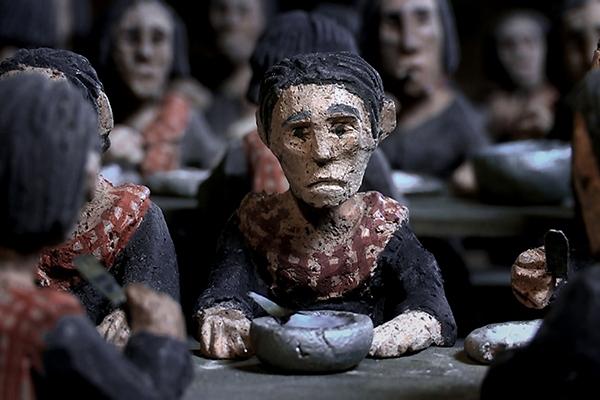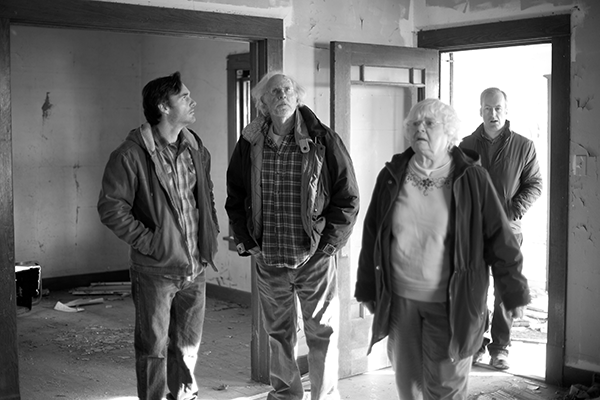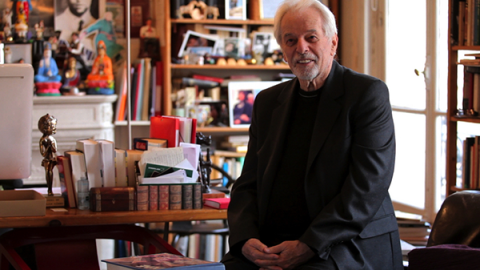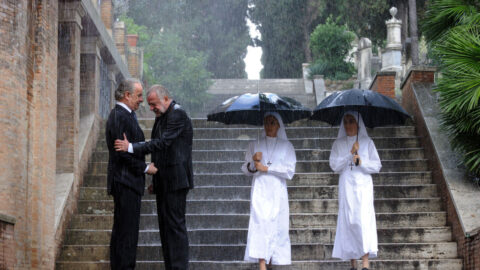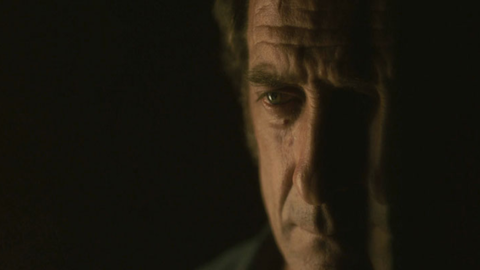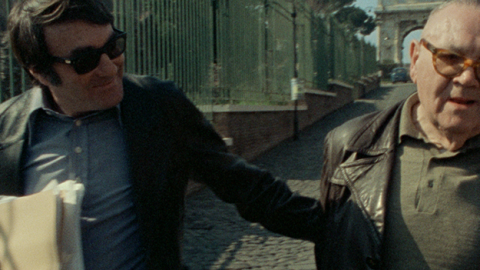Here’s a peculiar fact about the Cannes International Film Festival: it is an excellent place to watch movies and a terrible place to think about them. The reason for this is simple. The instant a screening is over, the pressure is on to formulate an angle on what you’ve just seen. Thus the eternal popularity of the “theme” of any given year—there are even angles on the selection itself.
There’s no time and there’s no repose. The minute that one screening is over, four more are about to begin. Reports must be filed, blogged, tweeted. Dinner table discussions must flow. Within days, the hypotheses and polemical campaigns become the melody and the actual films are relegated to the backbeat. Is Blue Is the Warmest Color a genuine reflection of lesbian experience or a “slutty impostor”? Does Alexander Payne love his characters or hate them? Is Norte, the End of History Lav Diaz for Beginners, and would it have been Lav Diaz for Experts had it been eight hours long rather than four? All the while, there is the counter-melody of speculation. Before the first press screening begins, we have endless exchanges about why this film is in the main Competition while that film is in Certain Regard while that other film would have been better off in the Quinzaine. By the middle of the festival, when exhaustion has set in, the speculation reaches heights of sheer lunacy: somewhere around day seven, I was assured that Mahamat-Saleh Haroun’s Grisgris was going to win the Palme d’Or “because it’s the first African film Spielberg has ever seen.” By the time the end rolls around, we all have a good cry as we remember the first time we saw The Breakfast Club.

Last of the Unjust
Claude Lanzmann’s new film, The Last of the Unjust, presented out of Competition, cannot be tagged and grouped according to any topical theme—it can be confronted head-on or not at all. As a film and as a moral inquiry, Lanzmann’s immense new work nullifies all urges to generalization. The same could be said of every film he’s ever made, but The Last of the Unjust has an added level of urgency. Like A Visitor from the Living, Sobibor, October 14, 1943, 4 p.m., and The Karski Report, the new film is largely comprised of footage that Lanzmann had originally shot in the Seventies. Unlike those earlier films, each of which operates in some way as a satellite of Shoah, The Last of the Unjust is not contained and compact but vast in scope. It is also a film made from a wholly different perspective in Lanzmann’s life and in the life of the memory of the Holocaust.
After a lengthy opening text, we see a formidable but now aged Lanzmann—he is almost 40 years older than he was when he conducted the interviews for Shoah—standing on the train platform of Bohušovice in the Czech Republic, where Jews were forced to disembark by the Nazis before they were herded to the alleged “model city” of Theresienstadt. The trains hurtle past, from the left and then from the right, and Lanzmann throws up his hands before the camera: “We can’t control the schedule.” Trains are, or course, the great recurring motif of Shoah, and the echo is at once clear and complex. In Shoah, many of the trains were older, steam-driven, and used for freight, while these are sleek modern passenger trains; similarly, the visual texture, in contrast to the 16mm images of Shoah, is immaculate HD. And where Lanzmann literally did control the schedule when he made Shoah, renting old trains and photographing them on the routes on which Jews were transported to Treblinka and Auschwitz, he begins his new film by quietly admitting defeat: the trains must stay on schedule, the world must change.
This admission will be echoed at the film’s end in a devastating summation from Benjamin Murmelstein, the last Jewish elder of Theresienstadt, one of the most misunderstood figures of the Holocaust, and the protagonist of The Last of the Unjust. “Listen—today, a member of the Jewish Council is like a dinosaur on a motorway,” says Murmelstein to Lanzmann as they stroll through the Roman sunlight. “What do you do with them?” Murmelstein is describing his own paradoxical role in history, but he could just as well be talking about Lanzmann, who has doggedly insisted on the necessity of memory as a lifetime practice rather than an item on a moral checklist, and in the process become a thorn in the side of official culture. They are both the last of the unjust (a pun on André Schwarz-Bart’s novel The Last of the Just), two dinosaurs lumbering down the motorway.
“I didn’t see a single monster in my time in the camp,” said Primo Levi in an interview (he was referring to the prisoners, not the captors). “Instead I saw people like you and I who were acting in that way because there was Fascism.” In this sense, Lanzmann and Levi have always seen eye to eye, but they diverge on one key point: for Levi the innocence of all Nazi victims, from the Sonderkommandos and the kapos to the perpetrators of the most bestial acts, must be stated and demonstrated; for Lanzmann, that innocence is a plain fact and thus uncontestable. In Shoah, he worked against the grain of the dominant viewpoints of the time, most notably that of Hannah Arendt, who famously insisted on a blurring of responsibility between torturer and victim. In The Last of the Unjust, he flies directly in the face of still-orthodox opinion by allowing Murmelstein, long despised for his tyrannical rule of Theresienstadt and for all intents and purposes considered a collaborator, to testify on his own behalf at long last. Built like a high-Hollywood character actor (think Thomas Gomez), delivering a brilliant narrative of his life and times in a rapid-fire torrent with a Jack Benny lilt, Murmelstein is one of the richest and most moving characters to appear in a film in ages, whether fiction or documentary.
The Missing Picture
Versed in mythology and literature, he compares himself variously to Scheherazade, Orpheus, and, most tellingly, Sancho Panza. Murmelstein understood immediately that the role of the Jewish elder was not tragic but comic, an iteration of the ancient tradition of the puppet ruler, put in place to be mocked and degraded. “The Elder of the Jews was always between the hammer and the anvil, the Jews and the Germans,” explains Murmelstein in his mellifluous voice, “and he can deaden a lot of blows.” As Murmelstein speaks, he entirely reorients our sense of Adolf Eichmann (with whom he was forced to work closely for seven terrifying years), of Theresienstadt and, above all, of his own reputation and historical legacy. And throughout the film, Lanzmann maintains a moving dual perspective by continually shifting back to himself, walking the sites of atrocities and desecrations and re-animating those events, movement by movement, through sheer force of will. He does so in a world that is very different from the one we saw in Shoah. Everyone is gone, victims, torturers, and bystanders. All traces of the past have been either expunged or officially memorialized. There are fewer every day who remember. The very framework of memory is dissolving. So the placement of events in the present tense, through Lanzmann’s reenactments and readings, through Murmelstein’s accounts and—startlingly, for the first time in a Lanzmann film—through judiciously employed photographs, footage (from the aborted Nazi-produced film The Führer Gives a City to the Jews), sketches, and watercolors, acquires its own ever-increasing urgency.
Rithy Panh’s The Missing Picture, which won the Certain Regard prize, is also an urgent call to memory in the aftermath of genocide but in an extremely different key, and it is tightly focused where the Lanzmann film is vast in scope. Panh, who is a driving force in the effort to bring Khmer Rouge leaders to justice and to rejuvenate the national cinema of Cambodia, lived his adolescence under Pol Pot’s regime and saw most of his family either disappear or perish from starvation before his eyes. There are no audiovisual records left of his past (the regime wiped out not only people but an entire shared life), so the filmmaker builds his missing images out of clay, papier-mâché, paints, and glue, in a serious of painstakingly crafted dioramas—of agricultural fields, the makeshift huts that served as communal living spaces, jungles and forests—interspersed with Khmer Rouge propaganda films and underscored by narration written by Panh and author Christophe Bataille and spoken by actor Randal Douc. The Missing Picture is a curious undertaking, at once extremely fragile and necessarily distanced—how could it be otherwise? Panh has constructed his film in such a way that he is implicitly calling upon the viewer to intuit layer upon layer of buried or suppressed emotion. Think of his new film as a dam constructed to control the flow of an ocean of sorrow.
All Is Lost, J.C. Chandor’s follow-up to Margin Call, screened out of Competition, and it might have been the most surprising film in the entire lineup. The film stars an aging Robert Redford, his damaged boat, the wayward shipping container that does the damage, and the Indian Ocean. Apart from an outstretched hand and a few figures in the extreme distance, Redford is the only human being on screen. He speaks about 300 words in the entire film, most of them in an off-screen reading of what is meant to be his unnamed character’s final letter to his loved ones, apologizing for whatever actions have led him to his solitary existence aboard the Virginia Jean. All Is Lost is an unexpected and fairly riveting entry in the small but proud collection of Robinson Crusoe–based cinematic fictions, from Roy Ward Baker’s Inferno to Buñuel’s adaptation of Defoe’s novel to Ichikawa’s Alone Across the Pacific to My Side of the Mountain. All Is Lost is probably closest to Baker’s 3-D film, in which Robert Ryan, left for dead with a broken leg in the middle of the desert, has to use his native intelligence to survive and make his way to civilization. In Chandor’s narrative, Redford’s character has every modern technological tool at his disposal, each one successively waterlogged, short-circuited, battered, broken, or drowned until all that’s left is man and ocean. The film would not have worked without an actor capable of generating an entire biography through his reactions, his gestures, his small temperamental asides to himself, his relation to the world. Redford’s Our Man (so says the IMDb listing) is wistfully but resolutely alone, initially bemused by his predicament, unnerved only at the most dramatic intervals, yet intensely focused and absorbed in his tasks from beginning to end, and you can almost see the abandoned family, friends, and co-workers back home in your mind’s eye.
Nebraska
Alexander Payne’s Nebraska, Joel and Ethan Coen’s Inside Llewyn Davis, and Jia Zhang-ke’s A Touch of Sin were three Competition highlights. Payne’s film, written by fellow Nebraskan Bob Nelson, also offers a biography of its central character delivered by unusual means, in this case a mosaic compiled one piece at a time from former friends, enemies, and lovers of Woody (Best Actor winner Bruce Dern), on the road from Billings, Montana to Lincoln, Nebraska with his son David (SNL alum Will Forte). Payne has always walked a fine line between sharp social observation that occasionally edges into satire (a little less satire with each new film, I think) and a rich sense of character. In Nebraska, shot in delicately toned black-and-white ’scope, he has made a film that is, at its core, an elegy for the Midwestern men of an earlier era and all the tales and dreams and heartbreaks they left unexpressed and buried beneath a habitually unfazed stoicism. There is a scene in which the entire family decides on the spur of the moment to visit their old family home, still standing but uninhabited since their departure. Memory, ruin, regret, and a vanished way of life, all in one sustained passage.
There’s also a road trip at the core of Inside Llewyn Davis, about an itinerant folk musician in early Sixties New York loosely based on Dave Van Ronk. Davis (Oscar Isaac), a miserably self-pitying specimen of humanity whenever he’s not singing and playing his guitar and an angel whenever he is, decides for no good reason to hitch his way to Chicago to visit the legendary real-life folk club The Gate of Horn. The trip is a hair-raising descent into the gray-on-gray netherworld of uncertainty, just like back home only more so, most of it in the company of a platitudinous junkie philosopher (John Goodman) and his tight- wound driver/consort (Garrett Hedlund). Like Nebraska, the Coens’ film is richly layered and deftly shifts between registers, ending as a dark, magical, comic fable of the mystery of luck, good and bad.
Jia’s first fully fictional film since 2006’s Still Life also takes to the road—please note: no common theme implied, just a bunch of movies that happen to have road trips—with four separate stories based on actual events in separate regions of China. For anyone who knows Jia’s work, A Touch of Sin’s opening confrontation on a mountain road in the Shanxi territory between knife-wielding bandits and a gun-wielding motorcyclist (Wang Baoqiang) makes for a quizzical viewing experience. Oddly enough, this passage is redolent of Leone, and once the violence erupts we are even closer to the signature films of Jia’s Japanese co-producer, Takeshi Kitano—the shootings are balletic, almost decorous, and borderline fanciful. Moreover, Wu Jiang’s performance as Dahai, the disgruntled protagonist from the first story, tilts his character toward the comic, halfway between Ben Stiller’s Greenberg and the late Yusaku Matsuda’s disparaging tutor in The Family Game.
A Touch of Sin
Yet the savagery of Dahai’s final rampage is no joke, and it sets the stage for three more tales of modern China: Wang’s Zhou San, a rootless, hollowed-out young man, makes a brief and unwelcome return journey to Chongqing for his mother’s 70th birthday, only to go off in search of his next thrill crime, executed with chilling efficiency in broad daylight; another young man (Luo Lanshan) finds a job in a high-end pleasure club in Dongguan (where the director himself makes a brief and hilarious cameo), falls in love with one of his co-workers, moves to another town, and finally gives way to the crushing weight of authoritarianism; and a young woman in Hubei (Zhao Tao, Jia’s wife and key actress), a receptionist at a massage parlor, wreaks vengeance on a local official after he taunts and humiliates her.
As the film moves forward, it accumulates detail and atmosphere, picked up by an attentive camera eye sensitive to the documentary moment. A sense of societal drift gradually forms, and unlike Antonioni’s characters, many of which are efficiently conceived embodiments of a despiritualized model of existence, Jia’s characters are beset by despair incrementally, one dehumanizing slight and barked order at a time, and the slightly stylized violence is aligned with their interior worlds, their trip-wire explosions of eminently satisfying rage that quickly subside. At the film’s end point, we are left with a portrait of a vast swath of society on the bottom end of China’s economic boom, collectively posing a final devastating question, as if the world were looking itself in the eye at long last.



